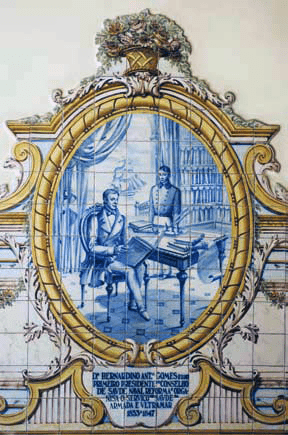Bernardino António Gomes Jr. facts for kids
Quick facts for kids
Councillor
Bernardino António Gomes Jr.
|
|
|---|---|
 |
|
| First Physician of the Royal Chamber | |
| In office January 1864 – April 1877 |
|
| Monarch | Luís I of Portugal |
| Preceded by | The Baron of Silveira |
| Succeeded by | José Eduardo de Magalhães Coutinho |
| Personal details | |
| Born | 22 September 1806 Santa Marinha do Outeiro, Lisbon, Portugal |
| Died | 8 April 1877 (aged 70) São José, Lisbon, Portugal |
| Spouse |
Maria Leocádia Fernandes Tavares de Barros
(m. 1837; died 1854) |
| Alma mater | University of Coimbra Faculté de Médecine de Paris |
| Scientific career | |
| Fields | Medicine, Anaesthesiology |
| Institutions | Royal Naval Hospital Saint Joseph's Hospital |
| Thesis | Dissertation sur les vers plats articulés qui existent chez l'homme, ou considérations sur la détermination de leurs espèces, des maladies qu'ils occasionnent, et du traitement qu'ils convient mieux de leur opposer (1831) |
Bernardino António Gomes (born September 22, 1806 – died April 8, 1877) was an important Portuguese doctor and scientist. He is best known for his groundbreaking work in anaesthesiology in Portugal. He was the first doctor in the country to use chloroform during surgery. This happened on January 12, 1848, during an operation on a knee tumor. He also helped make creosote and the first ether inhalers popular.
Contents
Bernardino António Gomes: A Life in Medicine
Bernardino António Gomes was born on September 22, 1806, in Lisbon, Portugal. His father, also named Bernardino António Gomes, was a famous doctor, chemist, and botanist. His mother was Leonor Violante Rosa Mourão.
Early Life and Education
Bernardino first studied Mathematics at the University of Coimbra. Later, he switched to studying Medicine. His studies were interrupted in 1828 because of the Liberal Wars, a civil war in Portugal. He joined the Academic Battalion, a group of students fighting in the war.
However, he soon left for Paris, France, where he finished his medical studies in 1831.
Joining the Liberal Cause
Bernardino António Gomes later rejoined the Liberal forces. He took part in important events of the Civil War, like the Landing at Mindelo. He also helped during the Siege of Porto, where he gave medical help during a cholera outbreak.
After the war, when the Constitutional Monarchy was set up in Portugal, he held many important jobs. He became the Director of the Royal Naval Hospital. He was also a doctor at Saint Joseph's Hospital. From 1837 to 1857, he was a Professor at the Lisbon Medical-Surgical School.

Fighting Epidemics
Bernardino António Gomes played a big role during the yellow fever and cholera outbreaks in the 1850s. He was sent to an important meeting called the International Sanitary Conferences in 1866. At this meeting, he strongly believed that diseases spread through contact. He thought it was important to stop ships from traveling to control the cholera pandemic. He wanted to fight the disease where it started or stop it as close as possible to its origin.
Debates and Royal Service
In 1858, Bernardino António Gomes had a public disagreement with the Duke of Saldanha. The Duke was promoting homeopathy and other alternative treatments. Bernardino António Gomes argued that these methods were not based on science. He felt the Duke was making people doubt real medical practices.
In 1864, King Luís I appointed him as the First Physician of the Royal Chamber. This was a very important position. Bernardino António Gomes had also been a personal doctor to King Luís I's brother, King Peter V. When King Peter V and two other royal family members died quickly in 1861, people were suspicious. Bernardino António Gomes performed the autopsy and announced that they had died from typhoid fever.
He also served as President of the Lisbon Society of Medical Sciences twice.
Contributions to Science
As a natural historian, Bernardino António Gomes studied ancient plants. He published a detailed review of fossil plants found in Portugal in 1865. He also helped create the 1876 Portuguese Pharmacopoeia. This was the first time Portugal's official book of medicines was put together by a group of doctors and chemists.
He married Maria Leocádia Fernandes Tavares de Barros in 1837. They had two sons who also became famous. One was Bernardino António de Barros Gomes, a botanist and priest. The other was Henrique de Barros Gomes, a statesman.
Awards and Honors
Bernardino António Gomes received many important awards from Portugal and other countries. These awards recognized his great contributions to medicine and science.
Portuguese Awards
 Knight of the Order of the Tower and Sword
Knight of the Order of the Tower and Sword Commander of the Order of Christ
Commander of the Order of Christ Commander of the Order of Saint James of the Sword
Commander of the Order of Saint James of the Sword
International Awards
 Officer of the Legion of Honour (France)
Officer of the Legion of Honour (France) Commander of the Order of Saints Maurice and Lazarus (Italy)
Commander of the Order of Saints Maurice and Lazarus (Italy) Grand Cross of the Order of Isabella the Catholic (Spain)
Grand Cross of the Order of Isabella the Catholic (Spain)


